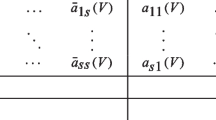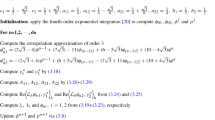Abstract
This paper is devoted to the explicit pseudo two-step exponential Runge–Kutta (EPTSERK) methods for the numerical integration of first-order ordinary differential equations. These methods inherit the structure of explicit pseudo two-step Runge–Kutta methods and explicit exponential Runge–Kutta methods. We analyze the order conditions and the global errors of the new methods. The new methods are of order s + 1 with s-stages for some suitable nodes. Numerical experiments are reported to show the convergence and the efficiency of the new methods.








Similar content being viewed by others
Explore related subjects
Discover the latest articles and news from researchers in related subjects, suggested using machine learning.Data availability
All data, models, or code generated or used during the study are available from the corresponding author by request.
References
Allen, S.M., Cahn, J.W.: A microscopic theory for antiphase boundary motion and its application to antiphase domain coarsening. Acta Metall. 27, 1085–1095 (1979)
Brugnano, L., Iavernaro, F., Trigiante, D.: Energy and quadratic invariants preserving integrators based upon Gauss collocation formulae. SIAM J. Numer. Anal. 50, 2897–2916 (2012)
Cong, N.H.: Explicit pseudo two-step Runge-Kutta methods for parallel computers. Int. J. Comput. Math. 73, 77–91 (1999)
Cong, N.H.: Explicit pseudo two-step RKN methods with stepsize control. Appl. Numer. Math. 38, 135–144 (2001)
Cong, N.H., Strehmel, K., Weiner, R.: Runge-kutta-nyström-type parallel block predictor-corrector methods. Adv. Comput Math. 10, 115–133 (1999)
Cong, N.H., Strehmel, K., Weiner, R.: A general class of explicit pseudo two-step RKN methods on parallel computers. Comput. Math. Appl. 38, 17–39 (1999)
Cox, S., Matthews, P.: Exponential time differencing for stiff systems. J. Comput. Phys. 176, 430–455 (2002)
Fang, Y.L., Liu, C.Y., Wang, B.: Efficient energy-preserving methods for general nonlinear oscillatory Hamiltonian systems. Act. Math. Sin. 34, 1863–1878 (2018)
Fang, Y.L., Yang, Y.P., You, X.: A new family of A stable Runge Kutta methods with equation dependent coefficients for stiff problems. Numer. Algo. 81, 1235–1251 (2019)
Feng, X.L., Song, H.L., Tang, T., Yang, J.: Nonlinear stability of the implicit-explicit methods for the Allen-Cahn equation. Inve. Prob. Imag. 7, 679–695 (2013)
Franco, J.M.: New methods for oscillatory systems based on ARKN methods. Appl. Numer. Math. 56, 1040–1053 (2006)
Hairer E., Lubich C., Wanner G.: Geometric Numerical Integration: Structure-Preserving Algorithms for Ordinary Differential Equations, 2nd edn. Springer, Berlin (2006)
Hayes, L.J.: Gelerkin alternating direction methods for nonrectangular regions using patch approximations. SIAM J. Numer. Anal. 18, 727–643 (1987)
Hochbruck, M., Lubich, C., Selhofer, H.: Exponential integrators for large systems of differential equations. SIAM J. Sci. Comput. 19, 1552–1574 (1998)
Kutta, W.: Beritrag zur näherungsweisen integration totaler differentialgleichungen. Zeitschr. für Math. u. Phys. 46, 435–453 (1901)
Li, J.Y., Deng, S., Wang, X.F.: Extended explicit pseudo two-step RKN methods for oscillatory systems \(y^{\prime \prime }+my=f(y)\). Numer. Algo. 78, 673–700 (2018)
Liu, C., Iserles, A., Wu, X.: Symmetric and arbitrarily high-order Birkhoff-Hermite time integrators and their long-time behaviour for solving nonlinear Klein-Gordon equations. J. Comput. Phys. 356, 1–30 (2018)
Liu, C., Wu, X.: Nonlinear stability and convergence of ERKN integrators for solving nonlinear multi-frequency highly oscillatory second-order ODEs with applications to semi-linear wave equations. Appl. Numer. Math. 153, 352–380 (2020)
Liu, C., Wu, X., Shi, W.: New energy-preserving algorithms for nonlinear Hamiltonian wave equation equipped with Neumann boundary conditions. Appl. Math. Comput. 339, 588–606 (2018)
Mei, L., Wu, X.: Symplectic exponential Runge-Kutta methods for solving nonlinear Hamiltonian systems. J. Comput. Phys. 338, 567–584 (2017)
Runge, C.: Ueber die numerische auflösung von differentialgleichungen. Math. Ann. 46, 167–178 (1895)
Wang, B., Wu, X.: A new high precision energy-preserving integrator for system of oscillatory second-order differential equations. Phys. Lett. A. 376, 1185–1190 (2012)
Wang, B., Wu, X., Meng, F., Fang, Y.: Exponential Fourier collocation methods for solving first-order differential equations. J. Comput. Math. 35, 711–736 (2017)
Weiner, R., El-Azab, T.: Exponential peer methods. Appl. Numer. Math. 62, 1335–1348 (2012)
Hochbruch, M., Ostermann, A.: Explicit exponential Runge-Kutta methods for semilinear parabolic problems. SIAM J. Numer. Anal. 43, 1069–1090 (2005)
Wu, X.Y., Wang, B.: Multidimensional adapted Runge-Kutta-nyström methods for oscillatory systems. Comput. Phys. Commun. 181, 1955–1962 (2010)
Wu, Y.J., Wang, B.: Symmetric and symplectic exponential integrators for nonlinear Hamiltonian systems. Appl. Math. Lett. 90, 215–222 (2019)
Acknowledgments
The authors are very grateful to the editor and anonymous referees for their invaluable comments and suggestions which helped to improve the manuscript.
Funding
This research is partially supported by the National Natural Science Foundation of China (No. 11571302), the Natural Science Foundation of Shandong Province, China (No. ZR2018MA024), the project of Shandong Province higher Educational Science and Technology Program (Nos. J18KA247, J17KA190), and the foundation of innovative science and technology for youth in universities of Shandong Province (2019KJI001).
Author information
Authors and Affiliations
Corresponding author
Ethics declarations
Conflict of interest
The authors declare that there is no conflict of interest.
Additional information
Publisher’s note
Springer Nature remains neutral with regard to jurisdictional claims in published maps and institutional affiliations.
Rights and permissions
About this article
Cite this article
Fang, Y., Hu, X. & Li, J. Explicit pseudo two-step exponential Runge–Kutta methods for the numerical integration of first-order differential equations. Numer Algor 86, 1143–1163 (2021). https://doi.org/10.1007/s11075-020-00927-4
Received:
Accepted:
Published:
Issue Date:
DOI: https://doi.org/10.1007/s11075-020-00927-4




